Flange Globe Valve
Flange Globe Valve
※ Swivel Plug Disc
※ Size Range: NPS 2 to NPS 24
※ Pressure Range: 150LB to 2500LB
※ Design STD.: API 600/ ASME B16.34
※ Flange Globe Valve Manufacturer
Introduction
A flange globe valve is a type of valve with a closure part (valve flap) that moves along the valve seat centerline. As per the valve flap movement, the changing of the valve seat port is proportional to the valve flap stroke. The stroke of closing or opening flange stem of this valve is comparatively short and it has a reliable cut-off function, changing the seat port affects the flap stroke proportionately which makes the globe valve suitable for fluid flow regulation. As such, flange globe valves are ideal for regulating or shut-off and throttling flow applications.
What is a flange globe valve?
The disk in a flange globe valve can be out of the path of flow or close to the path of flow entirely. The disk moves normally to the seat when closing or opening the valve. The movement creates an annular area between the seat rings which gradually closes when the disc is closed. This enhances the throttling capability of the flanged globe valve which is very important for regulating fluid flow. This valve has very minimal leakage relative to other valves like gate valves. This is because the flange globe valve has the discs and seat rings making a good contact angle which forms a tight seal against fluid leakage.
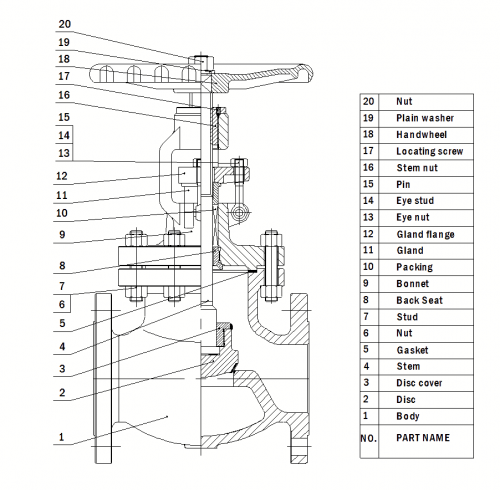
How does a flange globe valve work?
The flange globe valve consists of the body, bonnet, and handwheel. The bonnet holds the stem. The stem is turned using the handwheel. This makes the stem rise upwards and downwards through screw threads. The stem end part consists of plugs or discs. These discs are metallic or non-metallic and have different shapes depending on intended valve usage. The valve seat is mounted within the globe-shaped body. The seat divides the body into two chambers. The seat is made with a hole to allow the passage of fluid. When the valve is opened, the fluid flows up through the opening into the valve seat. To stop the fluid flow, the stem is screwed down till the seat opening is blocked using the disc. Also, a flange globe valve is used to modulate fluid flow. It modulates the flow by partially opening and adjusting the flow without terminating it. In flange globe valves, pressure loss occurs because the fluid meets some resistance due to friction, turbulence, and gravity. Loss in pressure and turbulence occurs because the valve forces the media to change flow direction. The pressure loss in the flange globe valve depends on the amount of friction during fluid flow.
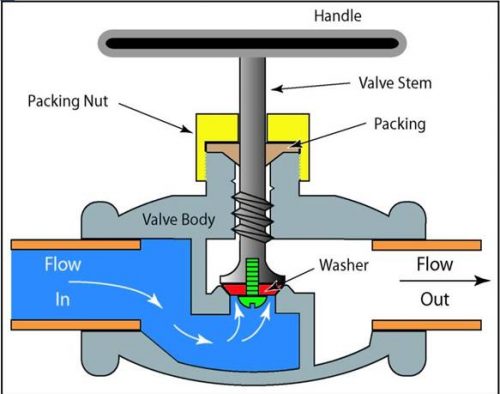
Components of flange globe valve
Valve body
The valve body is the main component of a flange globe valve as it is the component that keeps all the other parts together. The valve body houses all the internal parts of a flange globe valve to enhance fluid control. The valve body contains the ports that facilitate fluid flow in or out of the valve. The main feature of the valve body is high strength to ensure it can withstand high pressure and temperatures emanating from fluid flowing. Such strength depends on the material used to make the valve body. Some of the strong materials used to make the valve body include stainless steel and cast iron.
Seat/seat ring
The seat is one of the components of the flange globe valve used to seal the area between the stem and bonnet. The seat ring is screwed or torqued into the valve. The seat ring is used to provide a stable and replaceable shutoff surface.
Bonnet
Bonnet is one of the exterior components of the flange globe valve. The bonnet is connected to the valve body to ensure there is leak-proof closure. The bonnet type can be screw-in, union, or bolted.
The union bonnet is used to enhance strength and also makes it easier to do regular inspection and cleaning. The screw-in bonnet is of simple design and provides a pressure-tight seal to the valve body. The bolted bonnet, as the name suggests, is fixed in its position using bolts and nuts. The bolted type provides a superb seal against very high pressure.
Stem
The stem is the component in a flange globe valve used to connect the disc and the actuator (handwheel for manual valves). This helps to transmit actuation torque. The stem connects the actuator to the internal mechanism of the flange globe valve and thus it is regarded as one of the critical parts. When the flange globe valve is driven by actuators, the stem is smooth. However, if the valve is controlled manually, the stem is threaded. Smooth stem ends are threaded to enhance the connection to the plug and the actuator. Wearable packing is placed around the smooth stem to prevent fluid leakage. The stem is usually made of strong material to help it withstand compressive forces/stresses during closure and high tensile forces/stresses when opening.
Actuator
This is the component of the flange globe valve used to operate the disc and the stem to close/open the valve. Several types of actuators are available for a flange globe valve. These actuators depend on system requirements such as torque to open/close the valve, operating speed, and the need for automated actuation.
Packing
Packing in a flange globe valve is a gasket used to provide a strong seal between the bonnets and stem. The packing helps to prevent fluid from leaking in stuffing boxes and stems. Most flange globe valves have gland followers tightened to enhance leak-proof condition. When the packing is loose it may lead to fluid leakage. However, very tight packing may result to stem damage. Packing is made using different materials such as elastomers, PTFE, fibrous materials among others.
Plug/disc
Plug/disc in a flange globe valve moves normally to the seat. Plug movement helps to block or unblock fluid flow working as a physical flow barrier. The plug seats on the valve seat to block the fluid flow when the valve is closed. When the plug seats above the seat, it enables fluid flow.
Trim
Trim refers to internal components of the flange globe valve that are exposed to the fluid. Components of flange globe valve that constitute trim include disc, stem, seat surfaces, and seat.

Types of flange globe valve
Z-type flange globe valve
This is one of the most common types of flange globe valves. Z-type flange globe valve manufacturers employ a simple design on this valve. As the name suggests, this type of valve employs a Z-shape in the valve housing. The seat is on the Z-shaped partition. This type of flange globe valve has a horizontal seat. The horizontal seat allows the stem and disc to move perpendicular to the axis of the piping system which leads to loss of high pressure. The stem connects the opening/closing mechanism of the valve and it passes via the bonnet. The valve bonnet connects the opening on the valve housing head. This type of design results in a symmetrical design that enhances easier maintenance, manufacturing, and installation. The Z-type flange globe valve is used where throttling is needed and loss of pressure is not an issue.
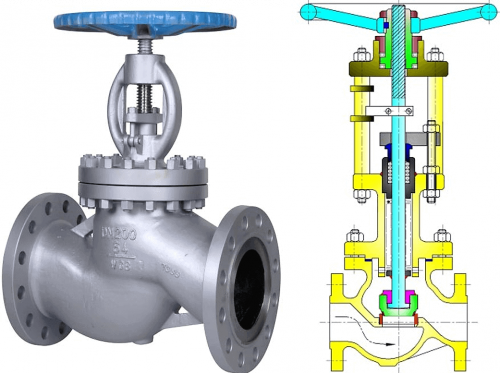
Y-type flange globe valve
This is a flange globe valve with a Y-shape. This type of valve is used to control fluid flow where there is a high drop in pressure. In a Y-type flange globe valve, the seat and stem rotate at an angle of around 45o to the axis of the pipe. This type of valve is used in applications with high pressure and where pressure drop is expected.
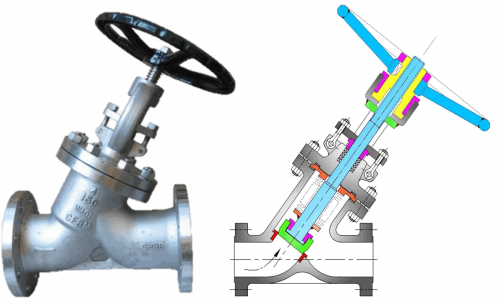
Angle flange globe valve
This is a flange globe valve that can turn fluid flow direction by an angle of 90o without any additional pipe elbow or weld. Angle flange globe valve manufacturers design this valve such that the disc can open in the opposite direction to the fluid flow. This type of flange globe valve design helps it to handle slag effects and variable flow conditions. The angle flange globe valve’s main advantage is that it can be used as a valve and a piping elbow.
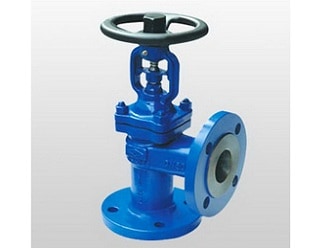
Bolted bonnet flange globe valve
This is a type of flange globe valve that uses bolts and nuts to mount the bonnets. This is the most common type of flange globe valve. The bolted bonnet valve needs a gasket to help seal the joint between the valve body and the bonnet.
Screwed bonnet flange globe valve
This is a flange globe valve that uses screws to mount the bonnets. This type of valve employs a simple valve structure. It is used for low-cost applications.
Welded-bonnet flange globe valves
These are flange globe valves in which the bonnet and the valve body are welded together. This type of flange globe valve design makes the valve leak-proof and suitable for high-temperature and high-pressure applications. This design is also necessary where the dismantling of the valve is not expected.
What should you consider when purchasing/selecting flange globe valves?
Media
This refers to the fluid or flowing components in the piping system. Some fluids are very dangerous because they can corrode the internal parts of the valve such acids. So when purchasing a flange globe valve buy one which will be resistant to corrosion or which will not be damaged by the fluid or media being controlled. This will depend on the materials used to make internal parts of the valve. Certain materials used to make internal parts of flange globe valves include PTFE which is preferred because of its resistance to corrosion as well as being chemically inert and insoluble.
Maximum pressure
Maximum pressure is the highest value of pressure that the valve is expected to work on. The maximum pressure will depend on the working pressure of the fluid/media flowing through the valve. If fluid the pressure is very high then a strong valve body will be needed. Strong valve bodies are made of strong materials such as carbon steel, stainless steel, cast iron among other materials. Very high pressure can damage the valve body and thus the whole valve. Also, very high pressure may cause fluid leakage and this could be dangerous, especially to hazardous fluids coming to the environment.
Maximum temperature
This is the highest temperature that the flange globe valve is expected to experience. Very high temperature requires that the valve be made of materials that can withstand such temperatures to avoid thermal distortion of the valve. Different materials used to make valves can withstand different levels of temperatures like PTFE which can withstand around 200oC while materials like stainless steel can withstand around 427oC.
Actuator
The actuator is the component of a flange globe valve used to provide the torque to open/close the valve. The actuator could be a manual wheel, pneumatic, hydraulic, electric operated. The type of the actuator depends on if the valve will be automated, semi-automated, or fully manual.
Applications of flange globe valves
- Flange Globe valves are used in water cooling systems to regulate water flow.
- They are used in turbines for oil systems.
- They are used in turbine seals and drain.
- Flange globe valves are used in chemical feedwater systems.
- They are used in main steam vents, heater drains, and drain systems.
- They are used in condensate air and extraction drain systems.
Advantages of flange globe valves
- Flange globe valves can use various actuators as per the customer’s choice.
- These valves employ a simple design and are easy to repair since the seat and disc can be easily accessed from the valve top side.
- These valves operate faster relative to gate valves because they have a short stroke length.
- Flange globe valves have good throttling capabilities.
- These valves have good shut-off capabilities.
- These valves are resistant to tear and wear.
- Several patterns of flange globe valves can be selected for different applications.
Disadvantages of flange globe valves
- Flange globe valves have a high-pressure drop.
- These valves have a high weight.
- These valves make more noise relative to other valves like gate valves.
- More power is needed to open the valves.
- Flange globe valves can be installed in one direction.
- Their installation and maintenance costs are high relative to other valves like gate valves.
Troubleshooting flange globe valves
Flange globe valve leakage in the packing
- The packing was not well-tightened. Tighten the packing evenly.
- Packing failure. Replace the packing.
- Insufficient packing rings. Add more packing pieces.
Flange globe valve sealing surface leakage
- Dirt accumulation on the sealing surface. Remove/clean the dirt.
- Damaged sealing surface. Replace the seat ring and disc.
Flange globe valve body connection between bonnet and body leaking
- The body and bonnet connection is not well-tightened. Tighten the connection (bolts or screws).
- Body-bonnet flange damaged. Repair the flange.
- A damaged metal sealing ring or failed gasket. Repair the metal seal ring or replace the gasket.
A disc cannot open/close or a handwheel cannot turn flexibly
- Crooked gland. Rectify gland.
- Over tightened packing. Loosen packing nuts.
- Stem bend. Rectify the stem or replace it.
- Screw threads on the stem are worn out. Replace the screw.
Broken body
- This happens due to excess internal pressure or due to external impact. Ensure the valve can withstand the internal pressure as recommended by the flange globe valve manufacturer. Replace the valve body. Identify the external cause of damage to make the valve safe in the future.
Summary
Flange globe valves are valves that have a flap as the closure part. The flap moves along the centerline of the valve seat. Flange globe valve controls fluid flow via disc or plug. The flange globe valve has a plug used to regulate fluid flow. The disc/plug is connected to the stem. The stem then connects to the handwheel or actuator. If the flange globe valve is manual, the valve operator applies torque on the handwheel to close/open the valve. When the handwheel is rotated, the valve opens/closes, and the plug moves to the valve seat. The plug movement creates space between the plug and seat ring to slowly shut the throttling flow. Flange globe valves are mainly used to enhance fluid throttling and shut-off. The main technical challenge with flange globe valves is that they have a high-pressure loss.
Flange globe valves are used in different applications such as water-cooling systems, heater drains, drain systems, main steam vents, chemical feedwater systems, plumping industries among others. The selection of flange globe valves needs to consider very important factors such as operation/actuator type, operating pressure and temperature, and type of media. Flange globe valves are used in several applications as they have several advantages such as the ability to close excellently, easy to do repair and maintenance, suitable for throttling application, and they can turn quickly.
